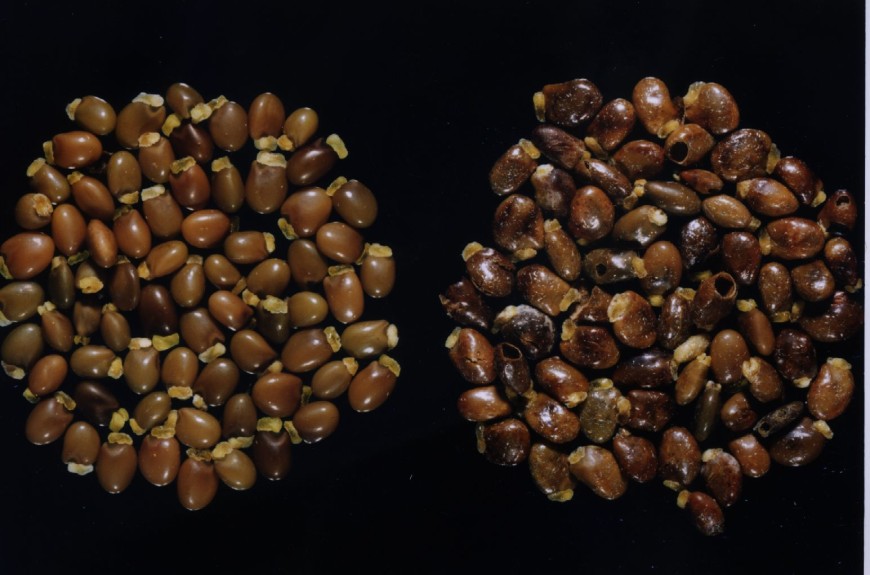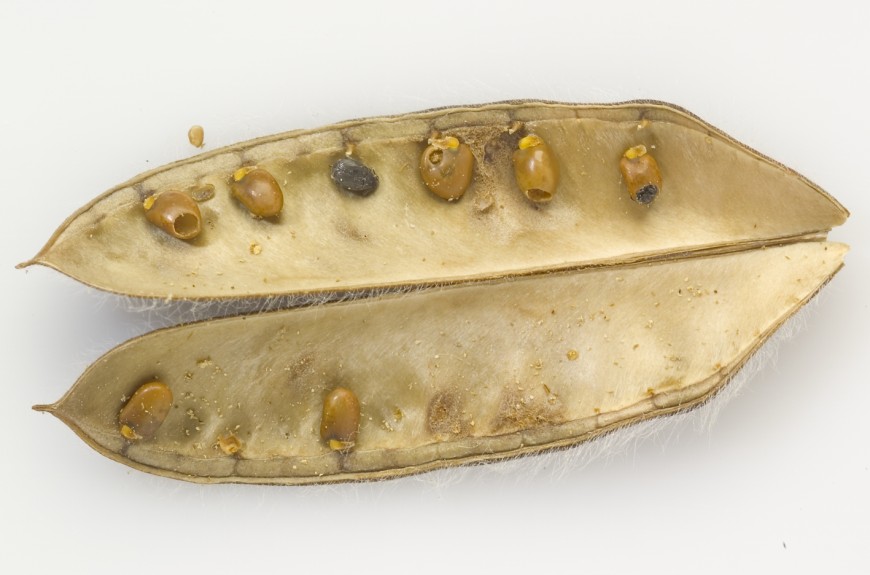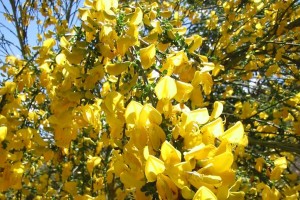Broom seed beetle
Image: broom seed beetles (Bruchidius villosus).
History in New Zealand
Broom seed beetles are native to Europe, and they were first imported from England by the DSIR in 1985. The beetles were mass-reared and released throughout New Zealand in the early to mid-1990s. Broom seed beetles are now widespread and common at sites in both the North and South Islands.
How would I find/recognise it and what is its lifecycle?
You are most likely to find broom seed beetles during the warmer months of the year. In spring, the adult beetles congregate on broom, tree lucerne and gorse flowers to feed on the pollen. You may be able to see the small (2-4 mm long) black beetles inside the flowers, or you can dislodge some by tapping flowers over a piece of white cardboard or material. The seed beetle can best be found when they are concentrated on the first- or last- flowering broom plants.
Image: adult broom seed beetle.
Female broom seed beetles lay their eggs on newly formed green pods. The eggs are just visible to the naked eye as shiny spots, smaller than the size of a pinhead, and are often laid close to the edge of the pod.
Image: broom seed beetle eggs (white dots) laid on pods.
Once the larvae have hatched, the empty egg cases are easier to see, as they take on a whiter appearance. Each tiny newly hatched larva burrows through the pod wall and into a soft green seed. If you open a seed pod in early summer, then you may be able to see infested seeds - they have a distinctive bulge and/or show discolouration. The larvae feed inside the developing seeds and once fully grown, pupate for a short period. After the beetles have completed pupation, the new adult beetle chews their way out of the seed staying inside the seed pod until it bursts, releasing the beetles. Usually, they emerge from the seed before the pod has burst open but sometimes, they do not emerge until the seeds have been thrown to the ground.

Image: un-attacked seeds (left) vs. attacked seeds (right).
If you open up some intact ripe pods, then there is a good chance that you will see the new adults and hollowed out seeds inside. If you find a single creamy-white caterpillar inside a pod, this is the gorse pod moth (See Gorse pod moth), or if the caterpillar has finished feeding, the pod may be empty with an exit hole.
The broom seed beetle is easy to differentiate from other broom biocontrol agents.
See Broom leaf beetle, Broom psyllid, Broom twig miner.
Look out for new adult broom seed beetles feeding on pollen in the autumn to build up their reserves. The beetles hibernate during the winter and emerge to breed in the spring. There is only one generation a year, and the adults can live for about 1 year.
You may also see a tiny wasp-like parasite (Pteromalus sequester) that sometimes attacks broom seed beetle larvae (and gorse seed weevil larvae), although parasitism levels are usually low. If you notice tiny holes in pod walls, they are made by the parasite - the broom seed beetles are unable to chew their way out.
How does it damage broom?
The adults feed on the pollen of many flower species, but this is not harmful to these plants. Damage is done by the larval stage. Each larva feeds on and destroys one broom seed.

Images: damaged broom seed pod.
Will it attack other plants?
Broom seed beetles will only damage seeds of Scotch broom (Cytisus scoparius) and tree lucerne (Cytisus proliferus). Other species of broom are not attacked.
How effective is it?
Studies have shown that the beetle can destroy up to 90% of seed. Population models indicate that beetle impacts depend on plant pollination rates, which, in turn, depends on the local abundance of honeybees and bumblebees. In areas where pollination is high, seed set is high, and 90% seed destruction will not affect broom populations. In areas where seed set is low, then the broom seed beetle should cause a decline in broom populations.
How can I get the most out of it?
Broom seed beetles are becoming common and widespread. However, if they are not yet present in your area, you can accelerate dispersal by shifting some from an established site. Beetle impacts can be enhanced by discouraging beekeepers from placing hives close to broom stands.
How do I select a release site?
Read Guidelines for selecting release sites for biocontrol agents.
How do I collect it for release at other sites?
Read Guidelines for collecting, relocating, and releasing insect biocontrol agents.
You can either harvest beetles in the spring or infested pods in late summer.
Spring Method - Go to the site when between one-third and one-half of the bushes are flowering, as experience has shown that beetles are easiest to find at this time. As a general rule, this amount of flowering will occur in October but check as the timing will vary from site to site, and even from year to year. Choose some broom plants that have new flowers on them. Beat these flowers with a stick over a beating tray (or a large piece of white material or cardboard) for 5-10 seconds, and then collect any beetles that have been dislodged with a pooter attached to a compressor. Repeat until you have at least 500 beetles. If it takes you longer than an hour to collect this many beetles, then you should leave the site undisturbed for at least another year. It is also possible to collect beetles directly from plants using a garden-leaf vacuum, but this is more time consuming. You can also collect beetles by simply putting bags over flowering branches and shaking them to dislodge the beetles.
Autumn Method - keep an eye on how the pods are maturing at the site over the summer. It is important to leave the pods on the plant until they are mature and blackish-brown in colour. If you cut the pods too early, then the beetles may not be able to complete development and may die. However, if you leave it too late, then the pods will burst open and the beetles will escape. Be aware that a spell of hot weather can quickly cause pods to ripen. Generally, you will need to shift the pods in January, but the timing will vary from site to site, and even from year to year. You need secateurs or loppers, some sacks or a small tarpaulin, and a large vehicle to transport the infested broom material. Before you begin, open a few ripe pods and make sure that they are infested with the beetles. Now, cut off branches with ripe pods, and either put them into sacks or wrap them up in the tarpaulin. Be careful that broom seed cannot escape so that you do not inadvertently spread the weed around the countryside. Ideally you want to shift at least 1000 beetles to each site, so conservatively, you will need to shift several thousand pods (10-20 branches) to each new site. Transport your infested pods as quickly as possible to the new site - do not leave them lying about in the sun. At the new site, wedge the branches of infested pods into the bushes growing there.
Once the pods burst open, the beetles will then be able to find their host plant quickly, and there is less danger of pods going mouldy or getting blown away.
How do I manage the release sites?
Avoid activities that will interfere with the broom seed beetle's life cycle, e.g., avoid applying other broom control measures when pods, and therefore immobile beetle life stages, are present on plants - at other times of the year the adult beetles will be able to shift to undamaged broom. If you are undertaking control measures over a large area, then leave a few bushes nearby to act as a broom seed beetle reservoir. It is best to avoid herbicides if possible, but if they must be used it is possible to minimise harm.
Key Contact


